
Amaranthus is a cosmopolitan group of more than 50 species which make up the genus of annual or short-lived perennial plants collectively known as amaranths. Some of the better known names include "prostrate pigweed" and "love lies bleeding". Some amaranth species are cultivated as leaf vegetables, pseudocereals, and ornamental plants.

The Sonoran Desert is a hot desert and ecoregion in North America that covers the northwestern Mexican states of Sonora, Baja California, and Baja California Sur, as well as part of the Southwestern United States. It is the hottest desert in both Mexico and the United States. It has an area of 260,000 square kilometers (100,000 sq mi).

Fouquieria splendens is a plant indigenous to the Mojave Desert, Sonoran Desert, Chihuahuan Desert and Colorado Desert in the Southwestern United States, and northern Mexico.
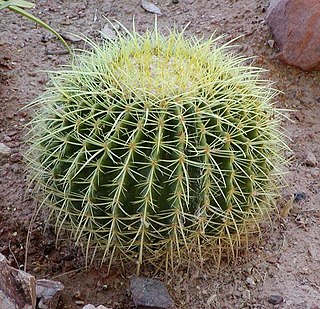
Barrel cacti are various members of the two genera Echinocactus and Ferocactus, endemic to the deserts of Southwestern North America southward to north central Mexico. Some of the largest specimens are found in the Sonoran Desert.

Parkinsonia microphylla, the yellow paloverde, foothill paloverde or little-leaved palo verde; syn. Cercidium microphyllum), is a species of palo verde.
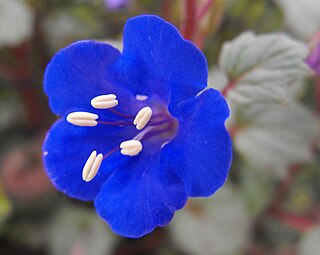
Phacelia campanularia is a species of flowering plant in the borage family, Boraginaceae, known by the common names desertbells, desert bluebells, California-bluebell, desert scorpionweed, and desert Canterbury bells. Its true native range is within the borders of California, in the Mojave and Sonoran Deserts, but it is commonly cultivated as an ornamental plant and it can be found growing elsewhere as an introduced species.

Prosopis velutina, commonly known as velvet mesquite, is a small to medium-sized tree. It is a legume adapted to a dry, desert climate. Though considered to be a noxious weed in states outside its natural range, it plays a vital role in the ecology of the Sonoran Desert.
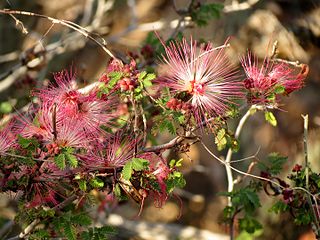
Calliandra eriophylla, commonly known as fairy duster, is a low spreading shrub which is native to deserts and arid grasslands in California, Arizona, New Mexico, Texas, and Mexico.

Atriplex hymenelytra, the desert holly, is silvery-whitish-gray shrub in the family Amaranthaceae, native to deserts of the southwestern United States. It is the most drought tolerant saltbush in North America. It can tolerate the hottest and driest sites in Death Valley, and remains active most of the year.

Condea emoryi, the desert lavender, is a large, multi-stemmed shrub species of flowering plant in Lamiaceae, the mint family.
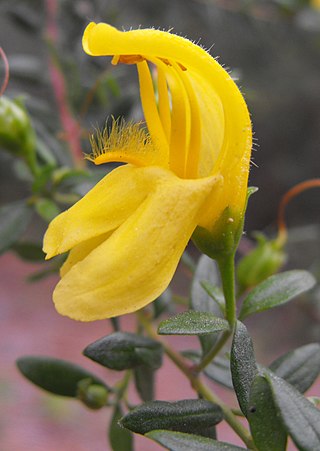
Keckiella antirrhinoides is a species of flowering shrub in the plantain family known by the common names snapdragon penstemon and chaparral beardtongue.

Baccharis sergiloides is a species of Baccharis known by the common name desert baccharis.

Rafinesquia neomexicana is a species of flowering plant in the family Asteraceae. Common names include desert chicory, plumeseed, or New Mexico plumeseed. It has white showy flowers, milky sap, and weak, zigzag stems, that may grow up through other shrubs for support. It is an annual plant found in dry climate areas of the southwestern deserts of the US and northwestern deserts of Mexico.

Greasewood is a common name shared by several plants:
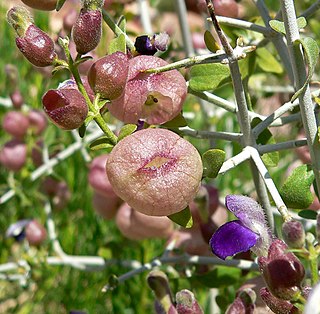
Scutellaria mexicana, commonly known by variants on bladder sage or paperbag bush, is a shrub of the mint family Lamiaceae distinctive for its calyx lobes that develop into small bag- or bladder-like shells around the fruits.
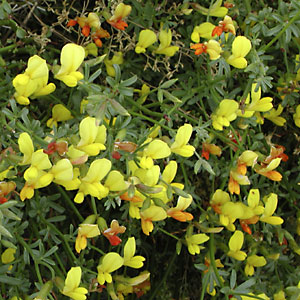
Acmispon rigidus, synonyms Lotus rigidus and Ottleya rigida, is a flowering plant in the pea family (Fabaceae), native to the southwestern United States and northwestern Mexico. It is known as shrubby deervetch or desert rock-pea. It is found in the Mojave Desert and Sonoran Desert.

Funastrum cynanchoides, also known as fringed twinevine, twining milkweed or climbing milkweed, is a perennial plant in the family Apocynaceae that grows twining through other plants in the Mojave Desert and Sonoran Desert. It has milky sap and smells pungent. It is similar to Funastrum hirtellum.
Flora of the Sonoran Desert includes six subdivisions based on vegetation types. Two are north of the boundary between the United States and Mexico, and four are south of the boundary. The flora of the Colorado Desert are influenced by the environment of the very dry and hot lower areas of the Colorado River valley, which may be barren, treeless, and generally have no large cacti. Flora of the Arizona Upland are comparatively lush, with trees and large columnar cacti that can withstand winter frosts. Those subdivisions of the Sonoran Desert which lie south of the international border are characterized by plants that cannot withstand frost.
Justicia longii, the longflower tube tongue, is an herbaceous perennial subshrub in the family Acanthaceae found in the Arizona Upland of the Sonoran Desert. Each of its white flowers blooms in the evening and lasts only a single night. The next morning the corollas fall, littering the ground with a white carpet. It has a long bloom season from April to October.
















